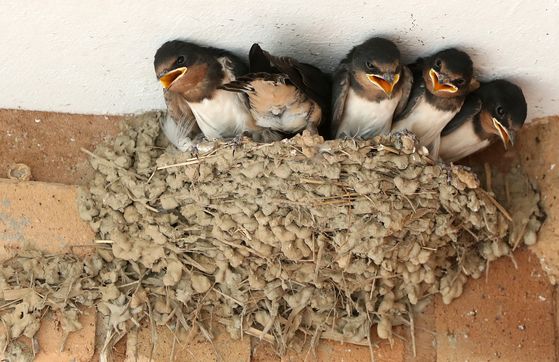![In the spring of last year, under the eaves of a building in Chuncheon-si, Gangwon-do, young swallows in front of Iso gather in a cramped nest waiting for their mother. [연합뉴스]](https://i0.wp.com/pds.joins.com/news/component/htmlphoto_mmdata/202101/12/d39437cb-721d-41f3-9555-bee0283c506f.jpg?w=560&ssl=1)
In the spring of last year, under the eaves of a building in Chuncheon-si, Gangwon-do, young swallows in front of Iso gather in a cramped nest waiting for their mother. [연합뉴스]
Jebi, who visits the Korean Peninsula every spring, is an outstanding architect. They make a nest out of mud on the underside of the eaves of a private house and lay eggs to raise their young. The bird’s nest is strong enough to withstand more than 100 times the load of a swallow. The secret can also be used in three-dimensional (3D) printing architecture, a cutting-edge architectural technique in the 21st century.
Seoul National University announced on the 12th that it discovered the scientific secret of the swallow’s nest as a result of a joint study of Professor Ho-Young Kim’s research team in the Department of Mechanical Engineering, Department of Mechanical Engineering at Sogang University, and Daegu Gyeongbuk Institute of Science and Technology (DGIST).
Swallows, which are migratory birds in summer, return to the soil nest under the eaves every spring to make a living. This nest shows that the swallow is a good architect, but people often forget it. From an engineering point of view, Swallow’s Nest is a masterpiece of optimal design and construction with the most easily obtained material. Birds that build houses stably attached to vertical walls, such as swallow nests, are estimated to be less than 5% of all bird species.
![3D printed artificial nest in the same proportions as the bird's nest. [사진 서울대]](https://i0.wp.com/pds.joins.com/news/component/htmlphoto_mmdata/202101/12/d0dd8457-e8d3-4187-97a4-21b12c445fb7.jpg?w=560&ssl=1)
3D printed artificial nest in the same proportions as the bird’s nest. [사진 서울대]
In order for the nest to stick to the wall, it must overcome the force pulled down by its weight, but the mud is very vulnerable to the original pull. The joint research team found that when the swallow’s saliva and the soil grains are mixed and hardened, the polymeric material contained in the saliva acts as an adhesive that bonds the soil grains together and withstands the pulling force very well. In addition, it was found that the swallow builds a house with special reinforcement in the part of the nest that receives the most strength. The nest made in this way can withstand a load of more than 100 times the weight of the swallow.
The way the swallow’s house is built is similar to 3D printing. 3D printing construction has recently been in the spotlight as a technology to quickly build buildings in places such as disaster sites. Swallows have to build their homes quickly when it is difficult to reuse their nests when they return to breed. Similar to 3D printing, swallows quickly create nests by stacking material (mud) layer by layer. The blueprint is the swallow’s instinct. It is estimated that swallows have been building their nests for about 10 million years ago.
Darwin, the founder of evolutionary theory, speculates in 『The Origin of Species』 that “the species of swallows who build houses with mud and saliva may have gradually evolved into species that build houses only with saliva by natural selection” Expressed. The secret of the swallow’s nest revealed by the research team this time provides an engineering answer to the surprises and questions Darwin had 160 years ago.
Professor Hoyoung Kim, the research director, said, “Through 3D printing technology that simulates the technology of building a swallow’s house, mathematical modeling, and fusion with biology, we have uncovered the scientific secrets of the familiar swallow nest.” It will be possible to accelerate the development of the biomimetic 3D printing technology used.”
The results of this research were published in the Proceedings of the National Academy of Sciences of the United State of America on the 12th.
Joonho Choi, Scientific and Future Reporter [email protected]
